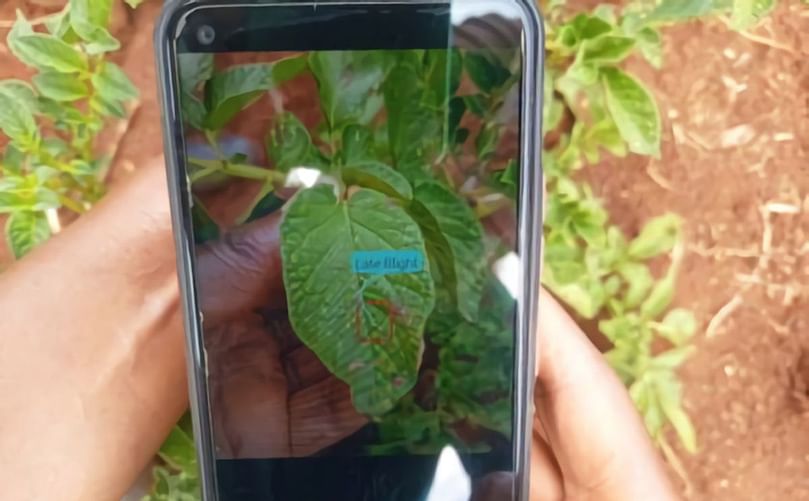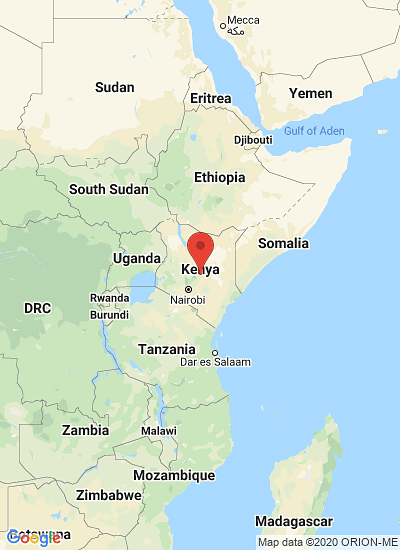Farmer Brian Chemase uses the Nuru app in his potato field. Courtesy: M. Korir/PlantVillage
Smartphone app Nuru helps farmers control potato and sweetpotato diseases

Pests and diseases destroy between 20 and 40% of crops globally, and farmers in developing countries are especially vulnerable to that destruction because they often aren’t sure what is affecting their crops. Or they lack good advice on how to control it. Lower yields and income loss often follow and contribute to hunger or malnutrition.
Helping small-scale farmers detect and control crop pests and diseases can improve their harvests and incomes but given the diversity and intensity of pest and disease threats, this is no small task. Most sub-Saharan African (SSA) nations have a fraction of the extension agents they need to reach all their farmers, ranging from one agent per 1,000 farmers to one for every 5,000-10,000 farmers, depending on the country.
To help overcome this challenge, scientists are using digital technologies to bridge the extension gap, and the recent addition of potato and sweetpotato diseases to the PlantVillage Nuru diagnostic app are important milestones in an ongoing initiative to help African farmers produce more food with the help of mobile phones.
Nuru (which means “light” in Swahili) is a free smartphone app that provides real-time diagnoses of plant diseases or pests in the field, even in areas outside mobile networks. It was developed by scientists at Penn State University and several CGIAR centers and forms part of PlantVillage – a farmer support platform that combines artificial intelligence and satellite technology with a corps of extensionists dedicated to promoting the use of those tools.
Nuru was launched in Africa in 2018 with the capacity to diagnose two cassava diseases (CMD and CBSD). It was subsequently expanded to cover fall army worm and desert locust, in collaboration with the Food and Agriculture Organization of the United Nations (FAO). Scientists with the International Potato Center (CIP) and Penn State have collaborated on the development of artificial intelligence (AI) for Nuru to diagnose sweetpotato virus infections and potato early blight and late blight diseases.
Sweetpotato virus diagnosis was added to the version of the app available on Google Play as of March 2022, whereas late and early blight diagnostics were added in late 2021. Potato and sweetpotato are increasingly important cash and food security crops in much of SSA, where they are primarily grown by smallholder farmers, who commonly suffer yield loss due to diseases.
Jan Kreuze, leader of CIP’s Crop and Systems Science Division:
"By providing farmers access to a quick diagnosis of the most serious diseases affecting some of Africa’s most important crops, this innovation is contributing to food and nutrition security and livelihoods."About 30 types of viruses can infect sweetpotato plants – spread by whiteflies, aphids, and planting material – and depending on the kind of combination of viruses, they can devastate yields. Late blight, a quick-spreading, wind-borne disease, can destroy 60% of a potato crop or more in a few rainy weeks if left untreated, which leads farmers to use large amounts of agrochemicals to control it. For both diseases, early diagnosis is vital for effective management.
Tools to boost yields
Kreuze explains that the AI that enables Nuru’s diagnostic capacity was developed with tens of thousands of photos of diseased and healthy plants and improved through repeated field evaluations. He explains that sweetpotato is especially challenging because viral infections are often asymptomatic, and the symptoms that are visible differ from one variety to the next.
To enable Nuru to diagnose viral infections in plants with few or no symptoms, researchers used diagnostic tests to identify asymptomatic infected plants, in hopes of teaching Nuru’s AI to detect symptoms that even experts might not spot.

Nuru now has the capacity to diagnose potato and sweetpotato diseases. Courtesy: M. Korir/PlantVillage
He adds that, while improving the diagnoses of diseases already in the app, his team is working to expand the number of pests and diseases it covers.
When Nuru diagnoses a disease, it connects farmers to information and guidance for controlling it on the PlantVillage website. In addition to being available to farmers who connect to PlantVillage via Nuru, that information is shared on TV shows, text messages for people with basic cell phones, and through groups of extensionists known as "dream teams".
Mathew Korir, a dream team member in Kenya, participated in the development of Nuru’s late blight diagnostic function and continues to support efforts to improve its algorithm.
Mathew Korir:
"The potato app is better than it was before, but I think that in a year, it will be perfect."Korir now promotes the use of the app by farmers, working with about 20 farmers who lead groups of between 20 to 100 farmers, who they in turn train. Because smartphones are still relatively scarce in rural areas, the leader of each group is given one to use the app. CIP distributed 240 smartphones to extension agents, seed producers, and farmer group heads in Kenya and Tanzania in 2021.
Mathew Korir:
"Nuru has helped farmers a lot. They’re learning more about late blight, how to prevent it and control it, and they are improving their potato production."By providing timely diagnoses and management guidance for farmers, Nuru facilitates quick action that can improve harvests. In the long run, it will also teach extensionists and farmers to recognize symptoms and deal with diseases and pests. As more people use it, and its pest and disease portfolio expands, this technology will make an important contribution to meeting the burgeoning food demand of Africa and other parts of the Global South.








